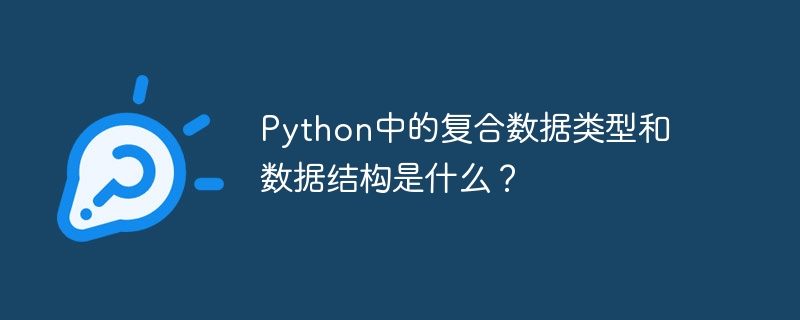Python中的复合数据类型和数据结构是什么?

在本文中,我们将解释Python中的复合数据类型和数据结构。
到目前为止,变量只能存储一个值。如果我们希望保存许多相关的值呢?
我们可以简单地为每个变量创建不同的变量。
但是如果我们不知道会有多少个值呢?
如果我们希望在循环中使用这些值,该怎么办?
复合数据结构是可以存储大量值的数据类型。
在Python中,有各种类型的复合数据结构。
我们将主要集中在列表上。
最后,我们将快速了解Sets, Tuples, and Dictionaries。
列表
在Python中,列表是一个有序的序列,可以容纳多种对象类型,如整数、字符或浮点数。在其他编程语言中,列表相当于数组。
列表只是由用逗号分隔并用方括号[]括起来的值组成的列表。
inputList = [“hello”, “tutorialspoint”, 1, 3.5, “python”]
列表操作
有许多操作可以对列表进行,以便从中创建表达式。
1)使用len()函数获取列表的大小
使用len()函数获取列表的长度/大小(len()方法返回对象中的项目数。当对象是列表时,len()函数返回列表中的项目数),并创建一个变量来存储它。
示例
# input list
lst = ["Hello", "TutorialsPoint", 78, "Hi", "Everyone"]
# getting list length
listLength = len(lst)
# Printing the size of a list
print("Size of a List = ", listLength)
输出
('Size of a List = ', 5)
使用索引访问列表元素
术语 "indexing" 指的是根据元素在可迭代对象中的位置来获取元素。
索引从0开始。序列中的第一个元素由索引0表示。
负索引从-1开始。序列中的最后一个元素由索引-1表示。
示例
# input list
inputList =[1, 4, 8, 6, 2]
# accessing the list element at index 2 using positive indexing
print("Element at index 2:", inputList[2])
# accessing the last element in list using negative indexing
print("last element of an input list:", inputList[-1])
输出
('Element at index 2:', 8)
('last element of an input list:', 2)
注意
当我们尝试使用不存在或过大的索引时,会抛出一个 IndexError
迭代列表
使用For循环
以下程序使用for循环打印所有列表元素:
# input list
inputList = [10, 20, 30, 40, 50]
print("Input list elements:")
# traversing through all elements of the list using for loop
for element in inputList:
# printing each element of the list
print(element)
输出
Input list elements: 10 20 30 40 50
列表项上的重复运算符(*)
Python List还包括*运算符,它允许你创建一个新的列表,其中的元素重复指定的次数。
示例
以下程序使用*运算符重复给定次数的列表-
# input list inputList = [5, 6, 7] # Repeating the input list 2 times using the * operator print(inputList * 2)
输出
[5, 6, 7, 5, 6, 7]
在这里,我们使用*运算符将随机值列表乘以两次,这样输出就是给定列表重复两次。
Python中的元组
元组是一个不可变的序列数据类型,可以包含不同数据类型的元素。元组只是由逗号分隔的Python对象的集合。由于元组是静态的,所以它们比列表更快。
列表和元组的语法有些不同。列表用方括号 [] 表示,而元组用括号 () 表示。
元组切片
我们可以使用元组切片。它与我们使用字符串和列表的方式类似。元组切片用于获取各种项。我们还使用切片运算符来执行元组切片。切片运算符可以用以下语法表示
[start:stop:step]
Example
的中文翻译为:示例
# Input tuple
givenTuple = ("Welcome", "this", "is", "TutorialsPoint", "Website", 10)
# Slicing with start and stop values(indices)
print('Tuple slicing from index 1 to index 6 :', givenTuple[1:6])
# Slicing with only stop values(indices)
print("Tuple slicing till index 7: ", givenTuple[:7])
输出
Tuple slicing from index 1 to index 6 : ('this', 'is', 'TutorialsPoint', 'Website', 10)
Tuple slicing till index 7: ('Welcome', 'this', 'is', 'TutorialsPoint', 'Website', 10)
使用索引访问元组元素
与列表一样,元组也使用索引来访问其元素。唯一的区别是元组是不可变的(不能被改变),而列表是可变的。
示例
的中文翻译为:示例
# input tuple
inputTuple = (1, 4, 8, 6, 2)
# accessing the tuple element at index 2 using positive indexing
print("Element at index 2:", inputTuple[2])
# accessing the last element in tuple using negative indexing
print("last element of an input tuple:", inputTuple[-1])
输出
('Element at index 2:', 8)
('last element of an input tuple:', 2)
注意
当我们尝试使用不存在或过大的索引时,会抛出一个 IndexError
Python中的字典
使用dict.keys()方法从字典中获取所有键的列表
使用 keys() 函数将其应用于输入的字典,然后使用 list() 函数(将序列/可迭代对象转换为列表)将结果转换为列表,以打印字典的所有键。
Example
的中文翻译为:示例
# input dictionary
demoDictionary = {10: 'TutorialsPoint', 12: 'Python', 14: 'Codes'}
# Printing the list of keys of a dictionary using the keys() function
# list() methods convert an iterable into a list
print(list(demoDictionary.keys()))
输出
[10, 12, 14]
结论
在这篇文章中,我们学习了复合数据类型和数据结构,以及它们的一些例子。
以上是Python中的复合数据类型和数据结构是什么?的详细内容。更多信息请关注PHP中文网其他相关文章!

热AI工具

Undresser.AI Undress
人工智能驱动的应用程序,用于创建逼真的裸体照片

AI Clothes Remover
用于从照片中去除衣服的在线人工智能工具。

Undress AI Tool
免费脱衣服图片

Clothoff.io
AI脱衣机

Video Face Swap
使用我们完全免费的人工智能换脸工具轻松在任何视频中换脸!

热门文章

热工具

记事本++7.3.1
好用且免费的代码编辑器

SublimeText3汉化版
中文版,非常好用

禅工作室 13.0.1
功能强大的PHP集成开发环境

Dreamweaver CS6
视觉化网页开发工具

SublimeText3 Mac版
神级代码编辑软件(SublimeText3)
 PHP和Python:解释了不同的范例
Apr 18, 2025 am 12:26 AM
PHP和Python:解释了不同的范例
Apr 18, 2025 am 12:26 AM
PHP主要是过程式编程,但也支持面向对象编程(OOP);Python支持多种范式,包括OOP、函数式和过程式编程。PHP适合web开发,Python适用于多种应用,如数据分析和机器学习。
 在PHP和Python之间进行选择:指南
Apr 18, 2025 am 12:24 AM
在PHP和Python之间进行选择:指南
Apr 18, 2025 am 12:24 AM
PHP适合网页开发和快速原型开发,Python适用于数据科学和机器学习。1.PHP用于动态网页开发,语法简单,适合快速开发。2.Python语法简洁,适用于多领域,库生态系统强大。
 PHP和Python:深入了解他们的历史
Apr 18, 2025 am 12:25 AM
PHP和Python:深入了解他们的历史
Apr 18, 2025 am 12:25 AM
PHP起源于1994年,由RasmusLerdorf开发,最初用于跟踪网站访问者,逐渐演变为服务器端脚本语言,广泛应用于网页开发。Python由GuidovanRossum于1980年代末开发,1991年首次发布,强调代码可读性和简洁性,适用于科学计算、数据分析等领域。
 Python vs. JavaScript:学习曲线和易用性
Apr 16, 2025 am 12:12 AM
Python vs. JavaScript:学习曲线和易用性
Apr 16, 2025 am 12:12 AM
Python更适合初学者,学习曲线平缓,语法简洁;JavaScript适合前端开发,学习曲线较陡,语法灵活。1.Python语法直观,适用于数据科学和后端开发。2.JavaScript灵活,广泛用于前端和服务器端编程。
 sublime怎么运行代码python
Apr 16, 2025 am 08:48 AM
sublime怎么运行代码python
Apr 16, 2025 am 08:48 AM
在 Sublime Text 中运行 Python 代码,需先安装 Python 插件,再创建 .py 文件并编写代码,最后按 Ctrl B 运行代码,输出会在控制台中显示。
 vscode在哪写代码
Apr 15, 2025 pm 09:54 PM
vscode在哪写代码
Apr 15, 2025 pm 09:54 PM
在 Visual Studio Code(VSCode)中编写代码简单易行,只需安装 VSCode、创建项目、选择语言、创建文件、编写代码、保存并运行即可。VSCode 的优点包括跨平台、免费开源、强大功能、扩展丰富,以及轻量快速。
 visual studio code 可以用于 python 吗
Apr 15, 2025 pm 08:18 PM
visual studio code 可以用于 python 吗
Apr 15, 2025 pm 08:18 PM
VS Code 可用于编写 Python,并提供许多功能,使其成为开发 Python 应用程序的理想工具。它允许用户:安装 Python 扩展,以获得代码补全、语法高亮和调试等功能。使用调试器逐步跟踪代码,查找和修复错误。集成 Git,进行版本控制。使用代码格式化工具,保持代码一致性。使用 Linting 工具,提前发现潜在问题。
 notepad 怎么运行python
Apr 16, 2025 pm 07:33 PM
notepad 怎么运行python
Apr 16, 2025 pm 07:33 PM
在 Notepad 中运行 Python 代码需要安装 Python 可执行文件和 NppExec 插件。安装 Python 并为其添加 PATH 后,在 NppExec 插件中配置命令为“python”、参数为“{CURRENT_DIRECTORY}{FILE_NAME}”,即可在 Notepad 中通过快捷键“F6”运行 Python 代码。






